Sexual Reproduction in Flowering Plants - Chp 39
1/54
There's no tags or description
Looks like no tags are added yet.
Name | Mastery | Learn | Test | Matching | Spaced |
|---|
No study sessions yet.
55 Terms
Characteristics of Asexual reproduction
1 parent involved
mitosis
no gametes
offspring genetically identical to parents
Characteristics of Sexual reproduction
2 parents involved
meiosis
gametes-zygotes produced
offspring genetically different from parents
Asexual reproduction
production of organisms from one parent only
Sexual reproduction
production of a new individual from the fusion of gametes from both parents
Gametes
haploid cells capable of fusion
Diagram of the structure of a flower
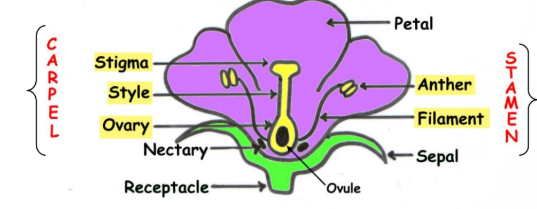
Sepal structure + function
green, leaf like structure - turns brown when the flower opens
protect the flower when its a bud
Petals structure + function
large, brightly coloured, scented
attract insects for pollination
Stamen structure + function
male part of the plant made up of the filament + anther
anther - produces pollen grains by meiosis
filament - supports the anther, supplies it with food + water
Carpel structure + function
female part of the plant made up of stigma, style + ovary
stigma - where pollen lands
style - where the pollen tube grows towards the ovary
ovary - contains one or more ovules
Receptacle structure + function
where flowering parts arise
supports the plant
Describe the structure of the anther
made up of 4 chambers called pollen sacs
each pollen sac is surrounded by the protective epidermis
underneath is the fibrous layer
underneath is the nutrient rich tapetum
inside is a diploid microspore mothercell aka pollen mothercell
Diagram of a transverse section of the anther
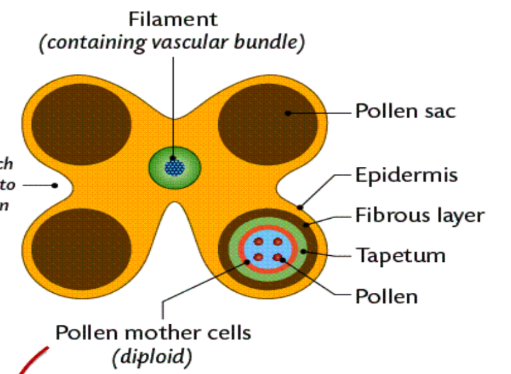
Describe the formation of the male gamete
the diploid microspore mother cell/pollen grain mother cell divides by MEOISIS
this produces a cluster of 4 haploid cells called a tetrad
the single tetrad breaks up to form 4 SEPARATE haploid pollen grains aka microspores
each pollen grain divides by MITOSIS to form 2 haploid nuclei: tube nucleus + generative nucleus
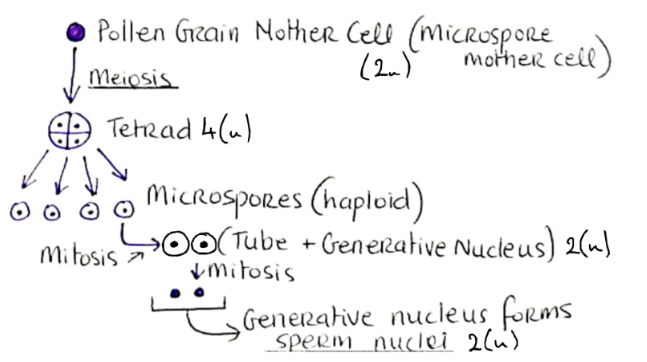
Describe the structure of a pollen grain:
Pollen grains are NOT gametes, it produces gametes
exine - thick, very strong outer wall
intine - inner lining
What happens once the pollen grians have matured?
the walls of the anther become dry and shrivel
they split (dehiscing), burst and expose the pollen grains
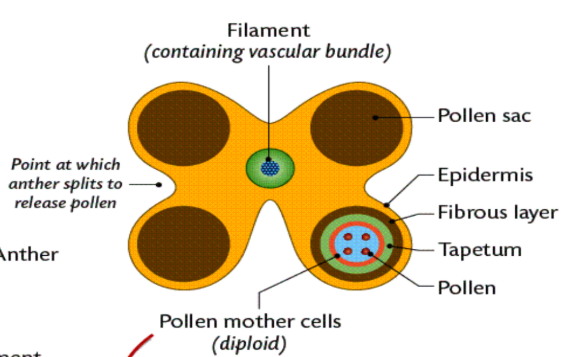
Describe the structure of the ovule:
Inside the ovary are a number of ovules, which are attached to the ovary wall by a stalk
nucellus - the bulk of the ovule + supplies nutrients
integuments - 2 layered walls for protection
micropyle - small pores for fertilisation
megaspore mother cell/emrbyo sac mother cell
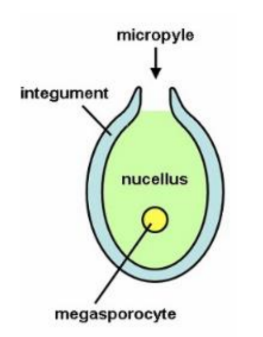
Describe the formation of the female gametes:
the diploid megaspore mothercell divides by MEIOSIS
this forms 4 haploid cells
3 of these degenerate, the remaining is the embryo sac/megaspore
the haploid embryo sac/megaspore divides by MITOSIS 3 times
this forms 8 haploid nuclei
5 of these degenerate, the remaining 3 form the female gametes
2 of these form the polar nuclei
the remaining one forms a thin cell wall and becomes the egg cell
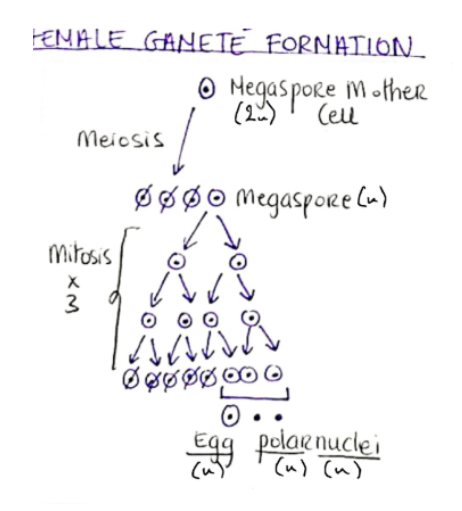
Diagram of a longitudinal section of a carpal + mature embryo sac
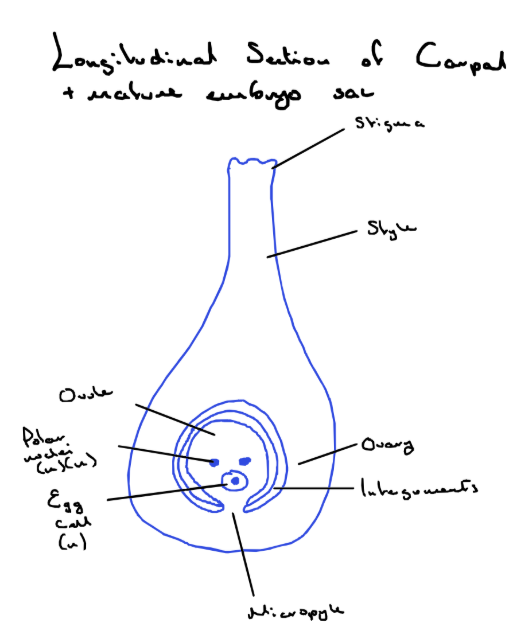
Pollination
transfer of pollen from anther to stigma of a flower from the same species
Self-pollination
transfer of pollen from anther to stigma on the same flowerC
Cross-pollination
transfer of pollen from anther to stigma on a different flower of the same species
Why is cross pollination more desirable for horticulturists than self pollination?
self pollination results in a less robust plant than cross pollination
What are 2 methods of pollination?
wind pollination
animal pollination
Example of a wind pollinated flower
grass
Example of an animal pollinated flower
wallflower
What are the differences between wind and animal pollinated plants?
Wind pollinated
small green petals
no scent or nectar
large amounts of pollen
large anther outside of petals
large and feathery stigma
Animal pollinated
large coloured petals
scent and nectar
smaller amounts of pollen
sticky pollen
small anther inside petals
small stigma inside petals
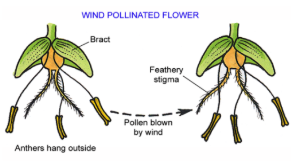
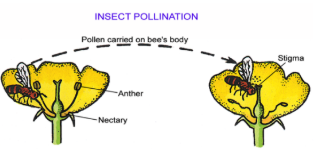
Name a condition in humans caused by a sensitivity to pollen:
Hay fever
caused by an allergic reaction to pollen
symptoms include sneezing, stuffy nose, watery itchy eyes
Fertilisation
union of male and female gametes to form a diploid zygote
Describe the growth of the pollen tube for fertilisation:
pollen grain lands on stigma
pollen grain is stimulated to grow by sugars produced by stigma to produce pollen tube
pollen grain divides by MITOSIS to produce the tube nucleus and generative nucleus
growth of the pollen tube is controlled by the tube nucleus
pollen tube grows from the stigma, down through the style, towards the embryo sac of the ovary
chemotropism - grows towards chemicals released from ovule
pollen tube stops growing when it meets the micropyle
2 haploid male gametes made by the generative nucleus move down through the pollen tube, and enter the embryo sac at the micropyle without the need for external water
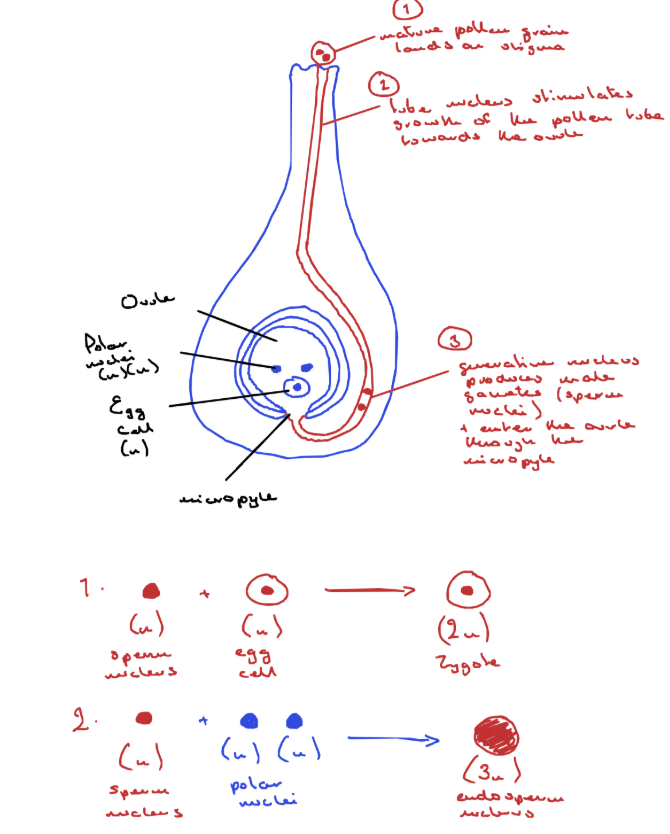
How many fertilisations occur in flowering plants?
2 - double fertilisation
What are the two fertilisations which take place + their products?
1st male gamete + Egg → Zygote
(n) + (n) = (2n)
2nd male gamete + 2 Polar nuclei → Endosperm (nucleus)
(n) + (n) + (n) = (3n)
Describe the formation of a seed:
the fertilised ovule becomes the seed
the integuments dry up and become the wall of the seed called the testa
the zygote divides by MITOSIS to become the young embryo plant
the young embryo plant is made up of the future root the radicle, the future shoot the plumule and the future seed leaves the cotyledons
at the same time the endosperm nucleus divides by MITOSIS to produce many triploid endosperm cells
these expand and absorb the nucellus and act as a food store of fats, proteins and starch
ovule → seed
integuments → testa
zygote → young embryo plant
radicle → root
plumule → shoot
cotyledons → seed leaves
Immature seed diagram
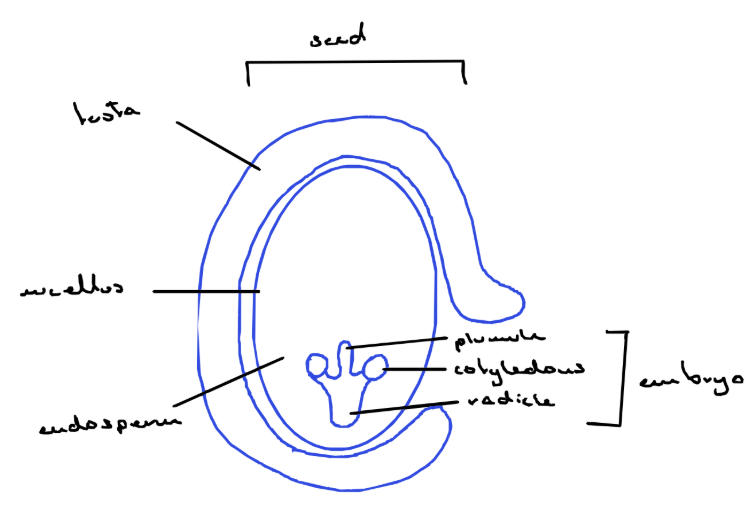
What are the differences between seeds that are monocots and dicots
Monocots
endospermic seeds
cotyledons only absorbs some of the endosperm
food stored in, and absorbed from the endosperm
Dicots
non-endospermic seeds
cotyledons grow a lot so all the endosperm in absorbed
food stored in the cotyledons

Example of a monocot seed
Maize
Example of a dicot seed
broad bean
Describe the formation of a fruit
a fruit is a developed ovary
growth regulators/auxins are produced by the seed, these influence the ovary to become a fruit
the ovary walll become the fruit wall called the pericarp
fruits are designed to protect seeds and help disperse them
What are the changes that occur in a flower after fertilisation?
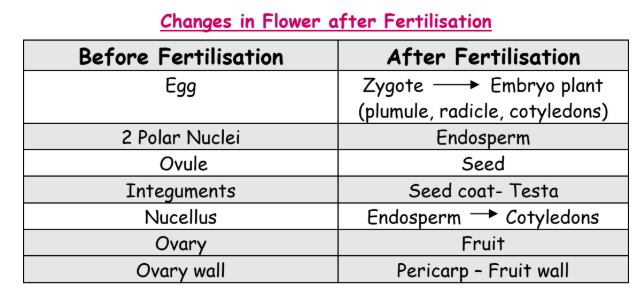
How are seedless fruits produced by horticulturists?
genetically
naturally
special breeding programmes
sprayed by growth regulators: if a large amount of auxin is sprayed a fruit can form without fertilisation
Dispersal
transfer of fruit or seed as far away as possible from the parent plant (ensuring survival and minimising competition)
What are the methods of dispersal?
Wind dispersal
seeds are small and light
seeds have parachutes eg. dandelion
Water dispersal
light air filled fruits float eg. water lily
Animal dispersal
fruits stick to the animals body with hooks called burrs eg. buttercup
animals eat the fruit and egest seeds
Self dispersal
fruit dries and and bursts to release seeds
Dormancy
a resting phase of reduced metabolic activity where seeds undergo no growth
What are the causes of dormancy?
chemical growth inhibitor (eg. abscisic acid) in testa
testa impermeable to water and oxygen
testa to hard for embryo to emerge
embryo is slow to develop to to lack of growth regulatr (can be due to reduced light or low temp like in winter)
How can dormancy be broken?
soaking seeds in water
physical damage to break the testa: abrasion, alcohol
exposing them to the light (or dark?)
exposing them to cold temperature, then a suitable temperature
What are the advantages of dormancy?
allows seed to withstand cold winter + recover from harsh conditions
allows germination in spring
allows time for dispersal
allows time for immature embryo to develop
Germination
is the regrowth of the embryo/seed into a new plant after a period of dormancy if the environmental conditions are suitable
What conditions are need for germination?
MOST
Moisture - enzyme activity + formation of cell sap
Oxygen - aerobic respiration
Suitable Temperature - enzymer activity
Describe what happens during germination:
begins when the seed absorbs water, through the micropyle, allowing acitvation of enzymes
food reserves are digested:
oils -lipase→fatty acids
starch -amylase→ glucose
protein -protease→ amino acids
glucose + amino acids → cell walls + enzymes
fats and glucose used to produce energy
products of digestion move to the growing embryo
the mass/dry weight of the seed falls as food stores are used up,
the embryo weight increases as it uses food to grow
radicle burst through the testa, the plumule and its leaves are visible above ground
the first leaves start to photosynthesise, and the dry weight increases again, but the overall dry mass decreases due to energy lost in respiration
Why is dry weight used?
different amounts of water in different seeds would affect the weight readings
Explain this graph
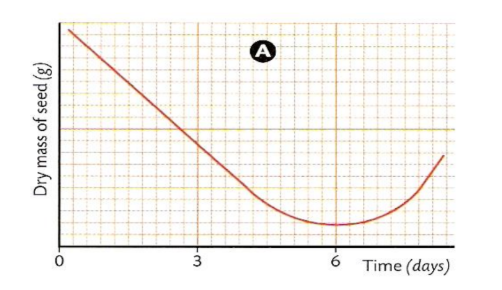
mass of the seed falls
respiration occurs and food is used by embryo
then photosynthesis occurs and the seed grows
Explain this graph
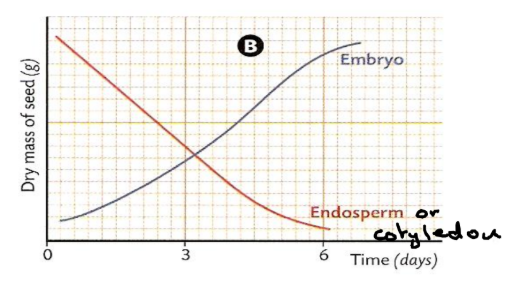
loss of mass in the endosperm/seed is matched by a rise in mass of the embryo
food is passing from the seed to the embryo
What are the 2 types of seedling growth + examples?
Hypogeal - cotyledon remains below the soil eg. broad bean
Epigeal - cotyledon moves above the soil eg. sunflower
Describe hypogeal seedling growth:
germination occurs, the radicle bursts through testa and grows downwards due to geotropism
plumule emerges and grows upwards, hooked over to protect leaves
cotyledons/endosperm shrival as food is transferred from them
once above ground the plumule straightens and its leaves begin to photosynthesise
Describe epigeal seedling growth:
cotyledon is forced out of the soils
once above soil the pericarp falls to the ground
the cotyledons open and photosynthesise
the plumule emerges from the cotyledons and forms the first true leaves